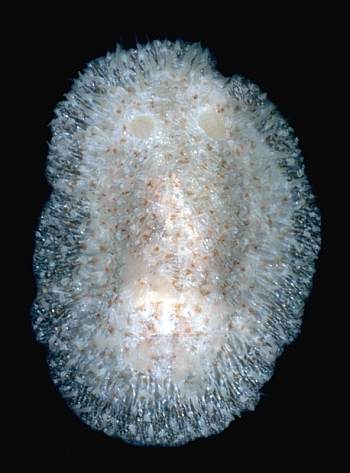
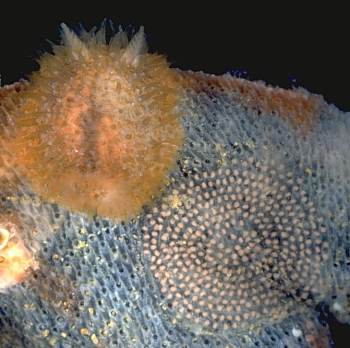
Onchidoris depressa
(Alder & Hancock, 1842)
Order: NUDIBRANCHIA
Suborder: DORIDINA
Superfamily: ANADORIDOIDEA
Family: Onchidorididae
DISTRIBUTION
This species is known from the British Isles and the Atlantic coast of Europe. It also recorded here from southeastern Australia (New South Wales, Tasmania) and from New Caledonia. This remarkably disjunct distribution, and presence in tropical waters would suggest that it has been artificially introduced to the southern hemisphere.
PHOTO
Upper: North point of Île Nou, Nouméa, New Caledonia. 11 October 1988, intertidal, on bryozoan with many egg masses, AM C156621.
Lower: near Hobart, southern Tasmania, Australia, 14 Feb 1984.
Photos: Bill Rudman
C141235
Onchidoris depressa is a flattened, ovate animal, which is probably often overlooked because of its excellent camouflage on the encrusting bryozoan colonies on which it lives and feeds. The mantle is translucent clear with scattered red-brown spots, especially in the mid-region, and covered with tapering translucent soft papillae. It can gave a glistening appearance form the crowded glassy spicules which are usually visble through the mantle skin This species seldom reaches more than 9mm in length. The rhinophores are sparsely lamellate and there can be up to 12 simple gills arranged in a circle around the anus. In the British Isles it is reported to feed on the bryozoan Schizomavella linearis. Alder & Hancock report the spawn to be 'pinkish'
References:
• Alder, J. & Hancock, A. (1842) Descriptions of several new nudibranchous Mollusca found on the coast of Northumberland. Annals and Magazine of Natural History, 9: 31-36.
• Alder, J. & Hancock, A. (1851) Part 5. In: A monograph of the British Nudibranchiate Mollusca: with figures of all the species. The Ray Society, London.
• Just, H. & Edmunds, M. (1985) North Atlantic Nudibranchs (Mollusca) seen by Henning Lemche. With additional species from the Mediterranean and north east Pacific. Ophelia, Supplement 2: 1-149.
• Thompson, T.E. & Brown, G.H. (1984) Biology of Opisthobranch Molluscs, Vol 2. Ray Society: London
Rudman, W.B., 2003 (October 13) Onchidoris depressa (Alder & Hancock, 1842). [In] Sea Slug Forum. Australian Museum, Sydney. Available from http://www.seaslugforum.net/find/onchdepr
Related messages
Re: Onchidoris depressa from Ratnagiri, India
April 16, 2010
From: Bernard Picton

Concerning message #22988:
Hi Bill,
I collected two Onchidoris depressa yesterday to compare with your records from India and the Pacific. I think they have some significant differences, but it would be interesting to try and get some DNA sequence data to compare. You will see from the attached photograph that Irish animals have much thinner tubercles than the Indian and Pacific specimens. Also the body shape seems more elongated and the markings are in longitudinal lines. Clearly they are camouflaging themselves on bryozoa, so the pattern and marks with central darker spots are designed (by evolution) to match the zooids of the bryozoan, a good example of convergence.
Locality: Murles Point, Mountcharles, Co Donegal., Low tide mark, shore., Ireland, Atlantic Ocean, 15 February, 2010, Intertidal. Length: 10mm. Photographer: Bernard Picton.
Bernard Picton
Bernard.Picton@nmni.com


Dear Bernard,
I agree that if all these animals are the same species then they have a remarkable ability to disperse and survive different temperatures. To my untutored eye the animals I first found animals in Tasmania look remarkably like your photos and their radular morphology is almost indentical.
As you suggest, it seems to be a case for DNA
Best wishes,
Bill Rudman
Onchidoris depressa from Ratnagiri, India
December 16, 2009
From: Vishal Bhave
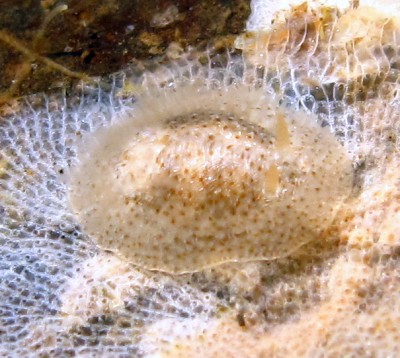
Concerning message #8642:
I have doubt about its identity but as a wide guess I think it is Onchidoris depressa!
Was seen on white colored bryozoa.
Locality: Rocky patch, Mandavi, Ratnagiri, 130 cm, Maharshtra, India, Arabian sea, 15 December 2009, Intertidal with rocks encrusted with bryozoans. Length: 6-8 mm. Photographer: Vishal Bhave.
Vishal Bhave
vishalbhave@gmail.com
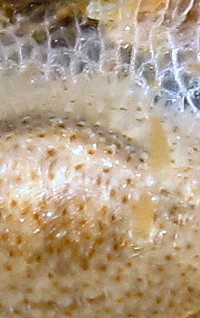
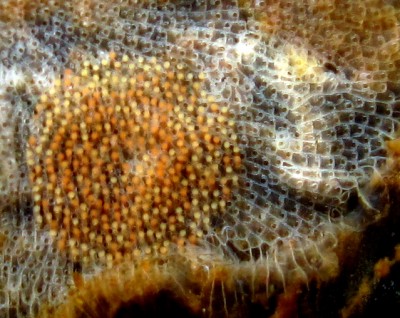
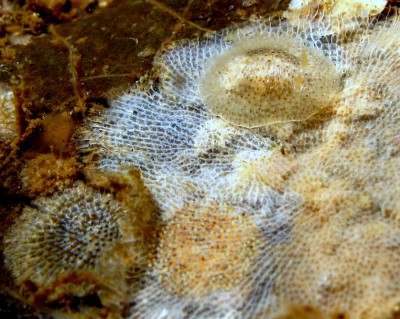
Dear Vishal,
I am pretty sure this is Onchidoris depressa. The brown spots and the long tapering mantle papillae seem quite distinctive characters. It is hard to believe an animal at home in the North Atlantic could be happy in the rather warmer waters of western India - but as I have found it in tropical New Caledonia and the much cooler waters of Tasmania, I guess it has a great temperature tolerance or perhaps is more than one very similar-looking species. As I said earlier, I can find no anatomical differences between New Caledonian and European animals.
These shallow water habitats you are investigating are proving very interesting
Best wishes,
Bill Rudman
Onchidoris depressa from Orkney, U.K.
November 30, 2009
From: Ian Smith

Concerning message #22812:
Dear Bill
As requested, here is a European specimen of Onchodoris depressa. I'm afraid the scanner hasn't made a very good copy of the 34 year old transparency. Thompson & Brown 1984 state "The mantle is so translucent that the eyes and the glistening calcareous spicules may be discerned with a lens". The spicules show well in my picture, especially over the dark gut.
Locality: Houton, Orkney, intertidal, Scotland, U.K., North Atlantic, 26 April 1975, rocky shore. Length: 5 mm. Photographer: Ian F. Smith.
The Korean pictures don't show the spicules as well and the slug seems less translucent, but this may be due to differences in photography; the brown substrate does show slightly through its mantle.
I sent specimens for confirmation to Tom and Greg, and this may be the 5 mm Orkney specimen they described the radula of in their 'Biology of Opisthobranch Molluscs' Vol 2. Ray Society, London 1984.
Best wishes
Ian
ifsmith@bethere.co.uk
Smith, I. F., 2009 (Nov 30) Onchidoris depressa from Orkney, U.K.. [Message in] Sea Slug Forum. Australian Museum, Sydney. Available from http://www.seaslugforum.net/find/22866Dear Ian,
Thanks for this photo. I think in photos, the clarity of the spicules is enhanced by the darkness of the digestive gland in the animal. Certainly the spiculation I have seen in animals from this part of the world, when looking under a microscope, match photos and drawings I have seen of European specimens.
Best wishes,
Bill Rudman
Onchidoris depressa? from Korea
November 24, 2009
From: Dong Bum Koh
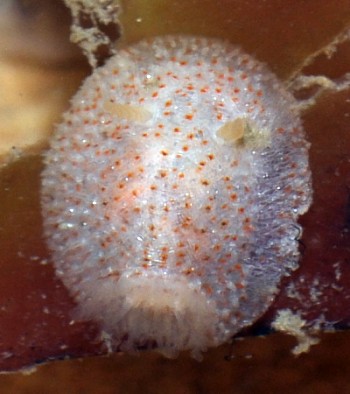
Dear Bill,
I've got unexpected seaslug from Yellow Sea of Korea.
I guess it as a Onchidoris depressa but I'm not sure.
Locality: Tae An Beach , -5m, South Korea, Yellow Sea, 22 Aug. 2009. Length: 0.5 cm. Photographer: JI Yeon Lee.
Could you help me for correct ID?
Best regards,
Dong Bum Koh
drkoh@seasee.co.kr
D.B.Koh, 2009 (Nov 24) Onchidoris depressa? from Korea. [Message in] Sea Slug Forum. Australian Museum, Sydney. Available from http://www.seaslugforum.net/find/22812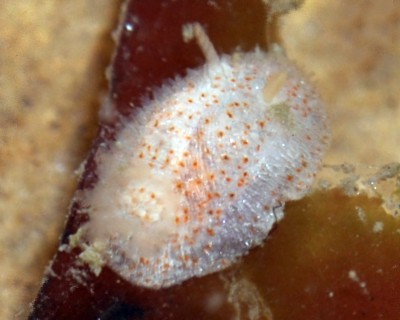
Dear Koh,
This is clearly the animal I have found in both tropical New Caledonia and the cool temperate waters of Tasmania. Both externally and anatomically I can find no differences between it and Onchidoris depressa from northern Europe. Your discovery of what externally appears to be the same species suggests it is a recent 'hitchhiker'. I would have thought if this species had been in the northwestern Pacific for any length of time it would have been noted by Baba or one of the many Japanese workers who have studied the fauna.
It would be nice to include some photos of European O. depressa on the Forum for comparison.
Best wishes,
Bill Rudman
Radula of Onchidoris depressa
October 15, 2003
From: Bill Rudman

To accompany my message about Onchidoris depressa from Tasmania, here is a scanning electron micrograph of the radula of a specimen from there. The radula looks identical to Thompson & Brown's (1984) illustration of the radula of Onchidoris depressa. In this species the large inner tooth has a large quadrangular base and a small denticulate hook on the outer corner. As usual in the genus, there is one small outer lateral tooth. In this photo there appears in some rows to be two small lateral teeth, but in fact the inner one of these 'teeth' is the broken outer edge of the large inner tooth. It has broken during the preparation of the teeth for the scanning electron microscope.
PHOTO: near Lauderdale, Hobart, Tasmania, Australia. 16 February 1984. AM C141255. Photo: Geoff Avern.
Best wishes,
Bill Rudman
Onchidoris depressa from Tasmania
October 15, 2003
From: Bill Rudman
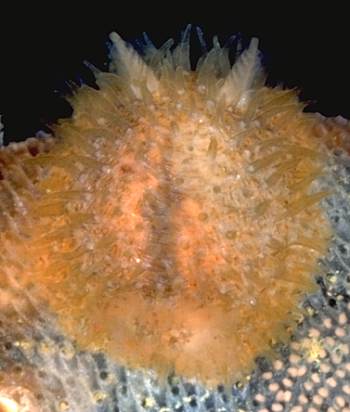

To accompany my message on Onchidoris depressa from New Caledonia, here are some records of this species from southern Tasmania. I thought at first that this was Acanthodoris nanega Burn, 1969 which is from the same region and is described to be very similar externally. However Burn described the radula as having 5 outer teeth, which is fairly typical of Acanthodoris whereas the radula of my specimens [see separate message] look identical to Thompson & Brown's (1984) illustration of the radula of O. depressa.
PHOTO: near Hobart, Sthn Tasmania, Australia, 14 Feb 1984. AM C141235. Lower photo also showing egg ribbon and bryozoan colony. Photos: Bill Rudman
Bill Rudman
Rudman, W.B., 2003 (Oct 15) Onchidoris depressa from Tasmania. [Message in] Sea Slug Forum. Australian Museum, Sydney. Available from http://www.seaslugforum.net/find/8642Onchidoris depressa from New Caledonia
October 15, 2003
From: Bill Rudman

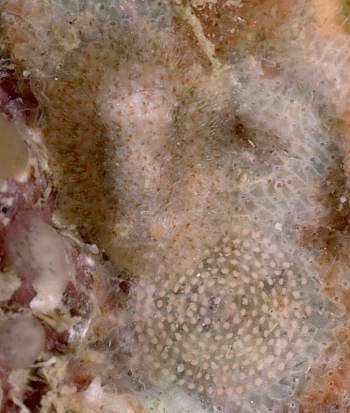
Colin Redfern's photos of the Corambe-like onchidorid? from the Caribbean, reminded me of these occurrences of what, I am pretty sure, is Onchidoris depressa, far away from its north Atlantic home.
These photos are from Noumea in tropical New Caledonia and show an animal, which in all external aspects matches O. depressa. It has the soft tapering papillae, the red-brown spots on the mantle, and the closely packed spicules ate clearly visible. I found it at two different sites, and one population were laying eggs which match thise of North Atlantic animals, and also the eggs of animals I have found in the cooler waters of southern Tasmania, Australia, which I describe in a separate message.
• North point of Île Nou, Nouméa, 11 October 1988, intertidal, on bryozoan with many egg masses, AM C156621.
• Îlot Freycinet, Nouméa, 1m, 23 October 1988, on bryozoan, AM C156672.
Bill Rudman
Rudman, W.B., 2003 (Oct 15) Onchidoris depressa from New Caledonia. [Message in] Sea Slug Forum. Australian Museum, Sydney. Available from http://www.seaslugforum.net/find/8643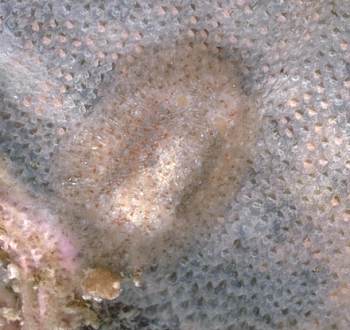
PHOTOS: All photos are of the Île Nou animals. The centre photo shows animal and egg ribbon on bryozoan colony. Lower photo shows animal on bryozoan. Photos: Bill Rudman
